WTI Crude Oil Analysis 18-22 August
This week’s analysis of West Texas Intermediate (WTI) crude oil shows a market characterised by bearish momentum, thin liquidity, and rangebound prices, with several key factors influencing price movements.
Price Movements and Technical Analysis –
Current Price and Trend: As of August 19, 2025, WTI crude oil is trading at approximately $63.08 per barrel, down 0.54% from the previous day, reflecting a 4.36% decline over the past month and a 13.79% drop compared to the same period last year. The overall trend remains bearish, with technical indicators suggesting continued downward pressure unless a significant breakout occurs. Posts on X indicate a bearish bias, with resistance at $62.50 and supports at $61.65, $61.30, and $60.80. The Relative Strength Index (RSI) is struggling near 50, and the 20-period moving average is below the 50-period moving average, reinforcing bearish momentum.
Recent Price Action: WTI has been forming bearish continuation patterns, with recent candles showing lower highs, lower lows, and lower closes. A bearish engulfing candle two weeks ago and a bearish spinning top last week highlight persistent selling pressure. However, some technical signals, such as a potential Fred Tam candle and bullish RSI divergence, suggest weakening downside momentum, which could indicate an early reversal if confirmed.
Key Levels to Watch: Analysts note a key resistance area around $63.30, with a potential pullback to $62.00 if prices break below $62.60. A weekly close above $64 could signal a shift toward bullish momentum, while failure to break this level may push prices toward the next major support at $55.
Fundamental Factors –
Geopolitical Influences: The market is heavily focused on geopolitical developments, particularly the upcoming Trump–Putin summit in Alaska, which has raised concerns about potential de-escalation of sanctions against Russia. Reduced fears of tougher sanctions have contributed to lower oil prices this week.
Inventory Data: U.S. crude oil inventories showed mixed signals, with a surprise increase of 3.0 million barrels for the week ending August 8, following a 3.0 million barrel drop the prior week. These fluctuations have kept markets jittery, with inventory levels countering some bullish sentiment from tariff threats.
Global Demand and Supply: Demand concerns, particularly from emerging markets like China and India, continue to weigh on prices. Limited supply growth due to challenges in developing new oil reserves also plays a role, though not enough to offset bearish sentiment. Rystad Energy’s analysis suggests global recoverable oil resources are stabilising, potentially capping sharp demand increases.
Economic Indicators: The Producer Price Index (PPI) data, indicating potential inflation resurgence, failed to lift crude oil prices significantly, suggesting that macroeconomic factors are not currently providing strong bullish support.
Market Sentiment and Trading Outlook
Liquidity and Volatility: Oil markets have experienced thin liquidity and rangebound trading, with WTI hovering around $61–$63 per barrel. volatility may increase with upcoming economic data releases, such as CPI, which could influence short-term price swings.
Trading Strategy: Analysts recommend a cautious approach. A long position may be considered only if WTI breaks above Thursday’s high, while staying on the sidelines is advised otherwise due to choppy, sideways market conditions. Some traders see a potential buy opportunity forming due to a falling wedge pattern, but the dominant strategy is to sell on rebounds unless prices break above $70.
Summary
WTI crude oil is under bearish pressure, trading near $63.08 per barrel with key support levels approaching at $61.30–$60.80. Geopolitical de-escalation fears, mixed U.S. inventory data, and weak global demand signals are driving the downward trend. Technical indicators show limited bullish signals, but a close above $64 could shift sentiment. Traders should monitor upcoming economic data and geopolitical developments, particularly the Trump–Putin summit, for potential volatility. For now, the market favours a bearish outlook unless a significant catalyst reverses the trend.
Note: Always conduct your own research, as market conditions can change rapidly. Technical ratings and sentiment are based on current data and may not reflect future movements.








